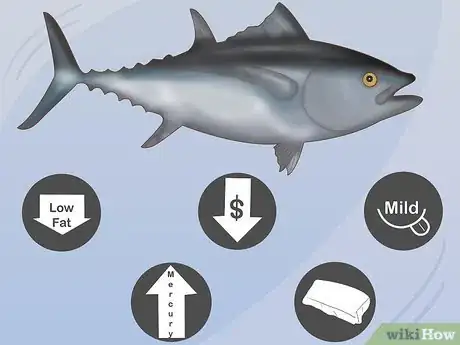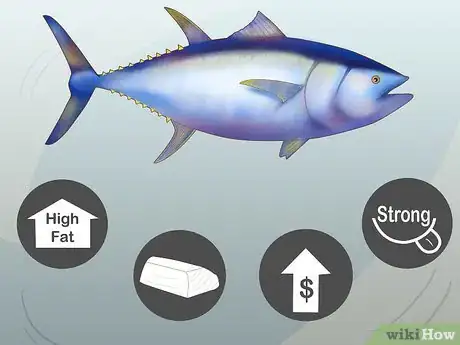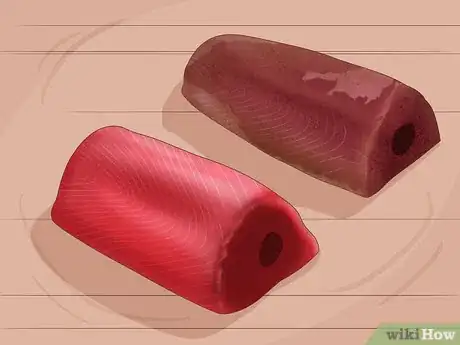This article was co-authored by wikiHow Staff. Our trained team of editors and researchers validate articles for accuracy and comprehensiveness. wikiHow's Content Management Team carefully monitors the work from our editorial staff to ensure that each article is backed by trusted research and meets our high quality standards.
There are 11 references cited in this article, which can be found at the bottom of the page.
This article has been viewed 18,495 times.
Learn more...
Whether you’re cooking a seafood dish for your family or you’re working in hospitality, it is important to know how to buy your perfect tuna steak. With over 15 species of tuna to choose from, knowing the difference between the main commercial tuna is crucial. High-quality tuna steaks can make or break the success of a tuna dish – by purchasing fresh, sustainably caught tuna, you will choose the very best steak for your recipe.
Steps
Choosing the Best Tuna Steak
-
1Start with Albacore tuna for basic, affordable meals. The most affordable tuna, Albacore tuna is characterized by its pale, white flesh and its low-fat content. Albacore tuna has the lightest flesh and the mildest flavor, so it is a great family choice.
- Albacore does have a mercury level three times as high as that of Skipjack tuna, so pregnant women and young children should limit their intake.[1]
-
2Choose Bluefin tuna for the perfect seared steak. The most prized for its flavor, Bluefin tuna is also the most expensive. Bluefin tuna is well-known for its dark ruby-red color, high fat content, strong flavor and silky texture.[2] The largest tuna variety, when the fish is mature the dark-red steak has an appearance similar to raw beef. It is perfect for a seared steak.
- While Bluefin tuna is often chosen for its strong flavor and silky texture, be aware that many Bluefin species are critically endangered due to overfishing.
Advertisement -
3Enjoy a mild flavor and light texture with Yellowfin or Bigeye tuna. Also known as ahi, the pale pink Yellowfin and Bigeye tuna are less expensive than the red Bluefin. Both Yellowfin and Bigeye tuna can be eaten raw. Their light texture and mild taste make the Yellowfin and Bigeye ideal for sashimi.
-
4Eat sustainably with Skipjack tuna. Making up more than 70 percent of the American canned tuna market, Skipjack tuna is an abundant and widely-fished tuna species.[3] Unlike its overfished cousins the Bluefin and Albacore, the Skipjack is a relatively small tuna that is known as one of the more ecologically sustainable tuna species. Skipjack tuna has a bold flavor, so its steak suits robust sauces and garnishes.
Purchasing Your Tuna Steak
-
1Research your local seafood stores. Find out which local stores, markets or supermarkets sell tuna near you. If you are lucky, your town may have a specialized fishmonger store or seafood market that will sell fresh tuna. If possible, locate a store that has a reputable fish counter. Stores with an in-house fish counter tend to have a higher turnover of seafood, which means you will be able to purchase fresher tuna.[4]
- Since tuna (especially high-quality tuna) can be expensive, visit your local store’s website to look at their tuna price range. If the tuna is too expensive, you could consider alternatives such as purchasing a frozen tuna steak.
-
2Look for high-quality tuna. High-quality tuna will range in color from deep red to pink. The best type of seafood seller will display tuna as a whole loin, and you can ask the butcher to cut steaks from the loin. If your store displays steaks that are already sliced, look for the ones that are moist, about one-inch thick, shiny, and almost translucent.[5]
- Tuna will taste best (and be less expensive) when they are in season, which is from May through to early September.[6]
-
3Aim to purchase the freshest tuna available. Ask the seafood attendant when and where the tuna was caught. For ultimate freshness, it is best to purchase as close to the catch date as possible.[7] Fresh tuna will look moist but not wet, and it will have a fresh sea-air smell rather than a strong fishy odor.[8] Tuna that looks dull, dry, flaky or is brown on the edges will most likely not be fresh. [9]
- All tuna steaks have a middle strip of darker meat running through them that should look moist, rather than flaky or dry. This meat has a strong flavor that some people may not like, but it is edible and nutritious.
-
4Purchase the tuna steak. Once you have chosen the right tuna steak required for your recipe, purchase the steak from the attendant. If you discover that the price is above your budget, you could consider buying a frozen tuna steak from the same store. Tuna are often processed and frozen so quickly after their capture that frozen tuna steaks are perfectly fresh.[10]
-
5Keep your tuna covered and refrigerated until you're ready to use it. Tuna dries out quickly, so place your steak on a covered tray or in a lidded container and store it in the bottom shelf of your refrigerator.[11] Your tuna should be stored at a temperature of 40 Fahrenheit or below and should be eaten within 2 days.[12] Alternatively, you can freeze the steak until you are ready to cook it.
- Due to the possible presence of parasites, all tuna should be cooked prior to eating. If you are going to eat raw tuna, freeze it first, as freezing will kill the parasites. To be safe, freeze tuna for at least 15 hours at -35 Fahrenheit.[13]
Warnings
- Overfishing of tuna has resulted in the decline and extinction of many tuna species. Even the ones that are still available are considered to be endangered to the point of extinction.[14] To eat sustainably, cross-reference the location of your tuna catch with the latest information from the Monterey Bay Aquarium Seafood Watch website: http://www.seafoodwatch.org/.⧼thumbs_response⧽
- Always say ‘no, thanks’ to wild-caught or farmed Bluefin tuna, as well as all types of tuna that are internationally caught with drifting longlines.[15] Longline fishing is controversial in many areas because of the risk of bycatch (killing of marine and bird life in the nets and lines used in the catch of commercial fish).[16]⧼thumbs_response⧽
References
- ↑ https://www.thespruceeats.com/varieties-of-tuna-1808817
- ↑ https://www.aboutseafood.com/tuna-council-3/tuna-species/
- ↑ https://www.greenpeace.org/usa/eat-tuna-know-fish/
- ↑ https://oureverydaylife.com/how-to-buy-fresh-tuna-12455875.html
- ↑ https://www.finecooking.com/article/what-to-look-for-when-buying-fresh-tuna
- ↑ https://www.bbcgoodfood.com/glossary/tuna
- ↑ https://www.menshealth.com/nutrition/a19521531/the-best-way-to-cook-tuna-steak/
- ↑ https://www.finecooking.com/article/what-to-look-for-when-buying-fresh-tuna
- ↑ https://oureverydaylife.com/how-to-buy-fresh-tuna-12455875.html
- ↑ https://www.menshealth.com/nutrition/a19521531/the-best-way-to-cook-tuna-steak/
- ↑ https://www.freshseafood.com/fresh-hawaiian-ahi-tuna-steaks.html
- ↑ https://www.freshseafood.com/fresh-hawaiian-ahi-tuna-steaks.html
- ↑ https://www.youtube.com/watch?v=dubc-WF1SQM
- ↑ https://www.bbcgoodfood.com/glossary/tuna
- ↑ http://www.seafoodwatch.org/seafood-recommendations/groups/tuna/overview?q=tuna&t=tuna
- ↑ http://safinacenter.org/2015/08/fishing-gear-101-longlines-the-snaggers/
























































